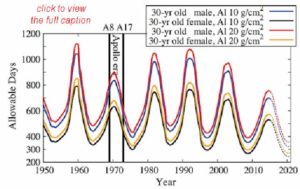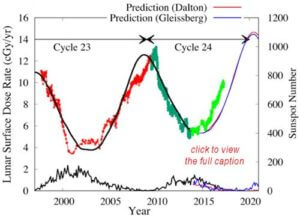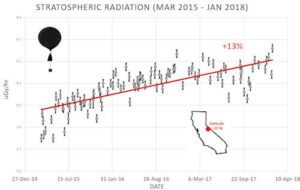
Dangerous cosmic radiation on Earth is getting stronger
 26. 03. 2018
26. 03. 2018

Cosmic radiation is bad - and it will be even worse! This is the result of a new study that was recently published in a scientific journal Space Weather. The authors, led by Professor Nathan Schwadron of New Hampshire University, show that cosmic radiation is more dangerous and amplified faster than expected.
The incident began four years ago when Schwadron and his colleagues first sounded an alarm over the cosmic radiation situation. Analyzing CRaTER data aboard NASA's Lunar Reconnaissance Orbiters (LRO) spacecraft, they found that cosmic rays in the Earth-Moon system had reached their highest level ever.
The worsening radiation environment poses a potential risk to astronauts. A number from their original 2014 report shows the number of days a 10-year-old astronaut can fly in a spaceship from a XNUMX g / cm aluminum barrier 2, before reaching the radiation limit prescribed by NASA.
In 1990, an astronaut could spend 1000 days in interplanetary space. In 2014… only 700 days. "That's a big change," says Schwadron. Galactic cosmic rays come from deep regions of space outside the solar system. It consists of high-energy photons and subatomic particles that are thrown towards Earth through Supernova explosions and other huge events in space.
In our first line of defense stands the sun: the solar magnetic field and the solar wind form a porous "shield" that tries to reflect the cosmic rays that penetrate the solar system. The sun's protective effect is highest during the solar maximum and the weakest during the solar minimum - hence the 11-year rhythm of the mission.
The problem is, as the authors note in their new work that the shield is weakening: “In the last decade, solar wind has exhibited low density and magnetic field strength, anomalous conditions that have never been observed before. The result of this remarkably weak solar activity is the observation of the highest cosmic rays. "
In 2014, Schwadron and his colleagues used a model of solar activity, to predict how bad cosmic radiation will be during the next solar minimum that is expected in 2019-2020. "Our previous work indicated an increase in dose rate from one solar minimum to another by 20%," Schwadron says.
"We can now see that the actual dose rate observed over the last 4 years with CRaTER has exceeded forecasts by about 10%, suggesting that the radiation environment is deteriorating even faster than expected." In this graph, the bright green points show the last surplus.
The data analyzed by Schwadron and colleagues comes from CRaTER in the LRO spacecraft in orbit around the moon, exposed to cosmic rays that the sun passes through.
Here on Earth we have two more defenders: the magnetic field and the atmosphere of our planet. They both reduce cosmic rays. But even on Earth, the growth is noticeable. Spaceweather.com and students from Earth to SkyCalculus have been putting space balloons into the stratosphere almost every week since 2015. The sensors onboard these balloons show 13% increase in radiation (X-rays and gamma rays) that penetrate the atmosphere of our planet.
X-rays and gamma rays are "secondary cosmic rays", which are caused by the drop of primary cosmic rays into the upper atmosphere of the Earth. They follow the radiation that falls down on the surface of our planet. The sensor power range - 10 keV to 20 MeV - is similar to that of X-ray equipment and airport security scanners.
How does it affect us?
Cosmic radiation penetrates commercial airliners and endangers passengers and crew, so pilots are classified by the International Radiological Protection Commission as workers with radiation exposure.
Some research shows that cosmic rays can cause lightning and clouds, which is why the weather and the climate may change. In addition, there are studies that link cosmic rays to heart rhythm disorders in the general population.
Cosmic radiation will intensify in the coming years until the sun falls to the lowest solar minimum.





 1
1


